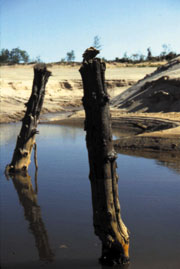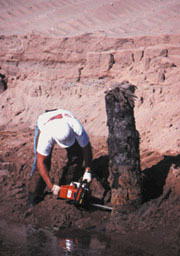geotimesheader
News
Notes
Paleobotany
Rapid warming
buried ancient forest
At the close of the
last Ice Age, a glacier retreated north toward what is now Lake Superior,
carving out a lower basin paradise for a spruce forest. The trees flourished
in the fluvial deposits for over a hundred years — while the frozen wall
of death stalked slowly back.
The Younger Dryas cooling event brought the glacier
south again, initiating the so-called Marquette re-advance, but it stopped
a few kilometers short of grinding down the forest. Instead of creating
spruce-splinters, a rapid warming of the climate preserved the trees intact.
The melting glacier deluged the drainage channels and riverbeds with water,
sand and gravel deposits. First the trees drowned as water submerged their
trunks, perhaps from a nearby flooded lake, and then, like a turned hourglass,
the sand and gravel deposits quickly and carefully enveloped the entire
forest.
| About 10,000 years later, a sand mining operation
uncovered the ancient branches, still soaked from being buried below the
water table.
“This was a very unique find,” says Dave Reed
of Michigan Technological University’s School of Forestry and Wood Products,
one of 10 on a team of scientists from Michigan Tech, Harvard, Duke University
and Iowa State University to study what they call the Gribben Forest. “It
was buried very gently, with everything still in place,” he says. The needles
on the forest floor and the moss were all still there.”
Discovered in Marquette County in Michigan’s Upper
Peninsula, the forest is revealing a remarkable story from the early Holocene
and the end of the last Ice Age.
Paleoecologists have used glacier trodden logs
and wood as indicators of past climates to help make inferences for the
future, but never before has an entire forest been preserved in such a
pristine condition. “This leads credence to the whole line of investigation,”
says Kurt Pregitzer, also of Michigan Tech and lead author of the study
on the forest published in the February Journal of Ecology. |

Saturated with water, the buried
trees turned a greenish hue, but did not rot.
Michigan Technological University.
|
The study concluded that the processes responsible
for forest population and growth rates for today’s advancing tree lines
are analogous to those that occurred in the Gribben Forest. The uneven
distribution of the forest with sites for seeds to land, grow and germinate
showed that tree migration was a patchy process. Competition was equally
as strong, as pollen found on the forest floor belonged to regional taxa,
but spruce dominated.
Today, forests grow in northern Ontario that are
similar in size and age to Michigan’s ancient forests. “It’s reassuring
to find that ecological processes have transcended time,” Pregitzer says.
The scientists uncovered more than 200 trees of
the pure-white spruce forest. The trees mostly ranged in age from 40 to
120 years, and the oldest was 145. Using two fallen logs and comparing
them to modern spruce trees, the scientists measured the height of the
forest to reach about nine meters (27 feet).

Chainsaws tore through 140 trees
preserved in the Gribben Forest. Michigan Technological University. |
In the fall of 1994, the tops of tree trunks
caught the attention of the Cleveland Cliffs Iron Company. They had uncovered
parts of the Gribben Forest before, in the 1970s, but this time the forest
proved far more extensive. To mine the sand, the crew had drained a pit
below the water table, about seven meters (20 feet) from the surface, and
accidentally uncovered parts of the forest. Researchers managed to collect
wood samples before the mining company finished for the season and reflooded
the site.
The National Science Foundation helped the scientists
by providing funding for exploration. Radiocarbon dates showed the forest
died 9,928 years (plus or minus 133 years) before present.
In the spring of 1995, the mining company again
drained the pit and helped the scientists collect samples by pumping the
water below the water table to the level of the forest floor.
|
The scientists worked with shovels and backhoes to
search out every tree they could find. Earthen dikes held back the water.
By the time the mining company had drained five acres of forest to a level
where scientists could dig out fallen spruce cones, the team had four days
to finish collecting their samples.
“Everybody we could pull out of the lab we had
help with the project,” Pregitzer says. Then the dikes gave way, flooding
the remaining trees and allowing the mining company to continue its excavation.
Except for what is now frozen forest samples stored at the university,
everything from the site is gone, Pregitzer says. “It was an unusual set
of circumstances.”
Because the forest remained below the water table,
the anoxic environment preserved the dead trees. The circumstances of their
death and preservation indicate a low energy, rapid burial.
After the trees drowned the needles fell off,
but the tiny branches, bark and buds stayed on — meaning the forest was
buried under sand and more water within a year after the trees died.
Additional research of the tree rings is now offering
the scientists further puzzles to pursue. Preliminary evidence does not
indicate the dramatic shifts in climate at the time.
“There are no indications of any unusual stress
or changes in climate in the decades before the trees were buried,” Reed
says.
Christina Reed

